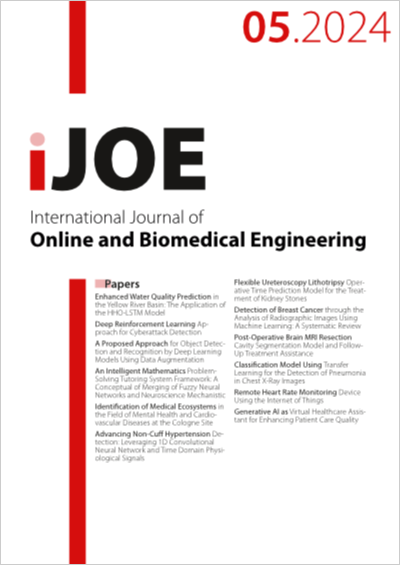Advancing Non-Cuff Hypertension Detection: Leveraging 1D Convolutional Neural Network and Time Domain Physiological Signals
DOI:
https://doi.org/10.3991/ijoe.v20i05.45547Keywords:
Hypertension (HT) Detection, Electrocardiogram (ECG), photoplethysmogram (PPG), Convolutional Neural Network (CNN), non-cuff methodsAbstract
Timely identification of hypertension (HT) is crucial for effectively managing and reducing the potential health consequences, including cardiovascular events such as heart attacks and strokes, as well as the development of kidney disease. Traditional cuff-based devices often discourage regular monitoring because they cause discomfort. Furthermore, the lack of symptoms in HT complicates the early detection of this condition. To address these challenges, our study employs a non-cuff methodology that utilizes unprocessed electrocardiogram (ECG) and photoplethysmogram (PPG) signals. We utilize a customized approach to enhance the features of a one-dimensional convolutional neural network (CNN) specifically tailored to optimize timeseries data. In contrast to previous research, our methodology avoids the need for complex signal extraction or transformation techniques. The main goal is to identify the optimal input signals and fine-tune the critical hyperparameters of CNNs. The clinical data underwent analysis, which revealed that the use of an integrated ECG and PPG approach resulted in the highest level of accuracy for detection. Notably, the F1 score achieved an impressive value of 98.88%. When evaluated separately, ECG outperformed PPG. Our study contributes to the advancement of the field by introducing a new approach that combines comfort and high accuracy in the early detection of HT. This method is practical and ensures a patient-friendly experience.
Downloads
Published
How to Cite
Issue
Section
License
Copyright (c) 2024 Nuryani Nuryani, Tri Pambudi Utomo, Nurhasan Agung Prabowo, Mohtar Yunianto, Aripriharta, Muhammad Yazid

This work is licensed under a Creative Commons Attribution 4.0 International License.


